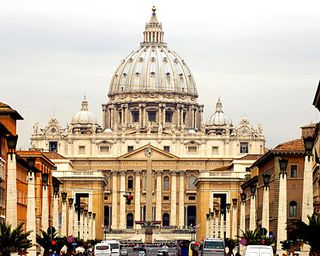 (Originally appeared on my blog at ncregister.com)
(Originally appeared on my blog at ncregister.com)
A correspondent writes:
I was wondering if you could comment some time about some of these spiritual promises that allegedly attach to certain prayers or devotions. The 15 promises of the rosary seems to be the most common example, but of course there's more.
There are more–and the reader goes on to name some–but for this post let's look at the alleged 15 promises regarding the rosary.
First, here is a commonly given text of them.
Before we go further, I should comment about a phrase that occurs in the very first promise, because it is not in common use today and startles everybody who runs across it for the first time. According to the first promise, those who pray the rosary faithfully shall receive "signal graces." What are "signal graces?" people ask.
The term "signal," used as an adjective, is not common in contemporary English, but what it means is "notable," "out of the ordinary," "uncommon" (cf. its entry in the Merriam-Webster Dictionary).
So "signal graces" just means "notable graces" or "unusual graces."
The 15 promises were, according to the common claim, "Given to St. Dominic and Blessed Alan." St. Dominic is a familiar figure, but "Blessed Alan" is less well known. He is Alanus de Rupe–also known as Alain de la Roche, and variants. He lived in the 1400s, over 200 years after St. Dominic's time. He reportedly received private revelation that showed him certain things about the life of St. Dominic, including the revelation of the 15 promises. This is why they are claimed to have been "given to St. Dominic and Blessed Alan." We don't have evidence–apart from Alan–that St. Dominic received these promises. The matter comes down to how much credibility one places in Alan's reported private revelation.
So how reliable are they?
It does not appear that there are any significant magisterial documents dealing with the subject. At least, advocates of the 15 promises do not seem to have identified any papal or curial documents affirming them (and there are certainly none from ecumenical councils). There might be some that are not commonly available in English, but until such can be identified it does not appear that the promises have ecclesiastical approbation on the global level.
What about the local level?
Here advocates of the 15 promises have identified something: a commonly printed pamphlet of the promises (pictured) that carries the imprimatur of "Patrick J. Hayes DD Archbishop of New York." (This pamphlet may possibly be excerpted from an earlier work carrying Hayes' imprimatur.)
The imprimatur is not dated, but Hayes was archbishop of New York from 1919 to 1938, so it would presumably have been granted in this period.
What weight would such an imprimatur have?
Actually, not a great deal. Imprimaturs do not mean that something is correct, and they are not the same thing or the equivalent of an ecclesiastical affirmation that a private revelation is authentic. As an archbishop living almost 500 years after Bl. Alan, in a country that had not even been discovered in Alan's time, Cardinal Hayes would not have jurisdiction to judge the authenticity of Alan's private revelation. His granting of the imprimatur, then, must be understood in terms of what imprimaturs normally signified in his day.
So what was that?
The 1917 Code of Canon Law was in effect during Hayes' time as the archbishop of New York, and under this code (as under the present, 1983 Code), there was a two-stage process in which a work would first be examined by a censor of books who would then make a recommendation to the ordinary (in this case, Cardinal Hayes) as to whether the book should be published. In issuing a favorable judgment, the censor would grant what is known as a nihil obstat, which is Latin for "nothing obstructs"–meaning that there is nothing int he book that would obstruct (prevent) its publication. In response to this, the ordinary would then (apart from unusual circumstances) issue the imprimatur which is Latin for "Let it be printed."
Now, the 1917 Code is rather clear on the criteria according to which censors are to grant the nihil obstat (BTW, gotta love the gangster character in a couple of Tim Powers' novels named "Neal Obstat"–nothing obstructs this gangster in pursuit of his ends! He's ruthless.):
Canon 1393
§2. Examiners in undertaking their office, leaving off all consideration of persons, shall have before their eyes only the dogmas of the Church and the common Catholic doctrine that is contained in the general decrees of the Councils or constitutions of the Apostolic See or the prescriptions and the thinking of approved doctors.
§3. Censors shall be selected from both clergies [who are] commended by age, erudition, ad prudence, and who in approving and disapproving doctrines, will follow the careful median.
As you can see, the criteria by which a censor is to evaluate a work are rather narrow. His own opinion of the correctness does not come into the matter. If it does not contradict (1) the dogmas of the Church or (2) the common Catholic doctrine of the councils and documents of the Holy See or (3) the prescriptions and thinking of approved doctors then he is not to disapprove it. Instead, he is to "follow the careful median," meaning that as long as the idea in question can claim a reasonable place in the spectrum of Catholic thought, it gets approved.
This understanding is reflected in John Abbo and Jerome Hannan's classic commentary on the 1917 Code, The Sacred Canons. Their commentary on this canon (vol. 2, p. 627) notes:
Censors are to be guided, as to matters in which the Church has not spoken, by the unanimous or almost unanimous views of authors. In controverted questions, they shall not refuse a favorable opinion because the book adopts a position at variance with their own. Nor shall they refuse it because they think the publication of the book inopportune, though they may inform the local ordinary of their opinion in this respect.
We may infer from the granting of the imprimatur that the 15 promises got through the nihil obstat stage, but you can see that this does not indicate that the censor believed in the authenticity of Bl. Alan's private revelation or that the promises are genuine–just that they aren't contradicted by the dogmas and doctrines of the Church and approved authors. Not being contradicted by these is not remotely a guarantee of truth.
It could very well be that the validity of these promises was a disputed question and the censor was bound by his obligations to grant the nihil obstat even though he did not personally agree with them.
In fact, there are hints that this may have been the case.
First, the promises were disputed. There had been significant controversy concerning Bl. Alan's purported revelations. According to the 1907 Catholic Encyclopedia,
His vision of the restoration of the devotion of the Rosary is assigned to the year 1460. Alanus published nothing during his lifetime, but immediately after his death the brethren of his province were commanded to collect his writings for publication. These were edited at different times and have occasioned much controversy among scholars. His relations of the visions and sermons of St. Dominic, supposed to have been revealed to Alanus, are not to be regarded as historical.
This volume of the encyclopedia, incidentally, also carries the imprimatur. In fact, it carries the imprimatur of Cardinal Hayes's predecessor, John Cardinal Farley, who was Archbishop of New York from 1902 to 1918. The nihil obstat that preceded this imprimatur would have been similarly granted whether the censor believed in the promises or not. It was a controverted question, and within a few years of each other the same archdiocese issued nihil obstats (and imprimaturs) on publications coming down on both sides of the issue–the pamphlet (obviously) approving of them and the Catholic Encyclopedia disapproving of them.
There is also another hint that the censor of the booklet may not have personally agreed with the promises, which is this: His name doesn't appear. The 1917 Code contains a provision which states:
Canon 1393
§4. A censor must give the decision in writing. If it is favorable, the Ordinary shall supply the power of publishing, to which, however, shall be attached the judgment of the censor signed in his name. Only in extraordinary cases and hence rarely in the prudent judgment of the Ordinary can mention of the censor be omitted.
The meaning of the statement regarding the omission of the censor's name was unclear to commentators of the day. Some took it to mean that the censor's name and the nihil obstat need to appear in the published work, along with the imprimatur, unless "only in extraordinary cases and hence rarely" the bishop deemed it prudent for this to be omitted.
"I don't agree with these promises, and I don't want my name on them lest people think that I do" would be such a circumstance, and Archbishop Hayes may have withheld the censor's name for that reason, leading to it and the nihil obstat not appearing on the pamphlet.
In fact, for all we know, the censor who approved the pamphlet may have been the same one who reviewed the Catholic Encyclopedia piece disapproving of the promises. We do know that man's name: Remy Lafort, S.T.D. (i.e., "doctor of sacred theology").
That's just speculation, and we can't even ultimately know why the censor's name was withheld, since publishing practice regarding this was inconsistent.
Thus far we've been considering the granting of the nihil obstat by the unknown censor, but what of the imprimatur granted by Cardinal Hayes?
As section 4 of the canon (quoted above) indicates, the granting of the imprimatur by the ordinary is treated as almost automatic: "A censor must give the decision in writing. If it is favorable, the Ordinary shall supply the power of publishing."
While imprimaturs were, and still are, routinely granted based on the recommendation of the censor, there are signal cases (remember that word?) where this isn't the case. Abbo and Hannan note:
The appointment of censors does not prohibit the bishop of the vicar general from inspecting books themselves; and even after they have received the opinion of the censor, they may refuse permission for publication, if motivated by a serious justifying reason (ibid.).
What's more, if permission to published was refused, they had to say why it was refused:
Canon 1394
§2. But if it seems that permission is to be denied, the reason shall be indicated to the requesting author, unless for a grave cause something else is indicated.
So put yourself in Cardinal Hayes's position: The validity of these promises is a controverted question among Catholic authors, but censors aren't supposed to base the nihil obstat on their own opinions and the nihil obstat has been granted. The Code expects that the imprimatur will follow the nihil obstat unless there is a serious reason why not, and you have to be prepared to tell the publisher what that reason is unless there is a grave reason why not.
"I personally don't think these promises are authentic" is not particular serious reason when the promises have been in circulation, in no doubt numerous publications in different languages, for about 450 years. The publisher could easily respond, "But what about all these other publications they have appeared in? Doesn't that show that these are mainstream enough that the imprimatur should be granted?"
We thus can't infer much about Cardinal Hayes' view of the promises (and, unlike the censor, he could not keep his name off them if he granted an imprimatur). He may have been a big supporter of them–or not. All we can conclude is that he didn't think them so problematic that he would refuse the imprimatur, given the circumstances.
In view of all this, it does not appear that we have sign off on the authenticity of the private revelation or the promises. Unless other documents–with something more than an imprimatur–can be produced, all we can say is that in the view of the Archdiocese of New York sometime in the tenure of Cardinal Hayes it was judged that the promises are not contradicted by (1) the dogmas of the Church or (2) the common Catholic doctrine of the councils and documents of the Holy See or (3) the prescriptions and thinking of approved doctors and that the promises were of a controversial nature, with some (like the publishers of the pamphlet) affirming them and others (like the Catholic Encyclopedia) rejecting them.
What are your thoughts?



